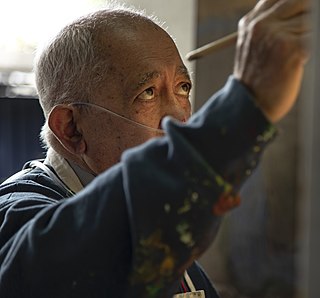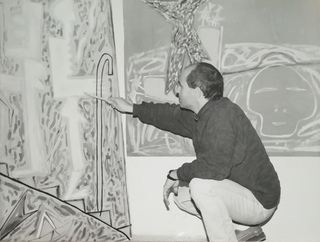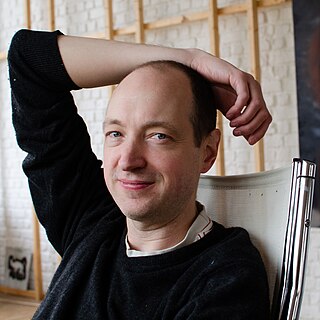Related Research Articles
Olga Costa was a Mexican painter and cultural promoter. She began to study art at the Academy of San Carlos but left after only three months to help support her family. However, she met her husband, artist José Chávez Morado during this time. Her marriage to him involved her in Mexico's cultural and intellectual scene and she began to develop her ability to paint on her own, with encouragement from her husband. She had numerous exhibitions of her work in Mexico, with her work also sent to be sold in the United States. She was also involved in the founding and development of various galleries, cultural societies and three museums in the state of Guanajuato. She received the Premio Nacional de Ciencias y Artes among others for her work.

Juan Soriano was a Mexican artist known for his paintings, sculptures and theater work. He was a child prodigy whose career began early as did his fame with various writers authoring works about him. He exhibited in the United States and Europe as well as major venues in Mexico such as the Museo de Arte Moderno and the Palacio de Bellas Artes. His monumental sculptures can be found in various parts of Mexico and in Europe as well. Recognitions of his work include Mexico's National Art Prize, the Chevalier des Arts et Lettres and membership in France's Legion of Honour.

Félix de la Concha is a painter. Born in León, Spain, he resides in Pittsburgh and Madrid.

Gladys Triana is a Cuban-American visual artist. Triana's career as an artist has spanned nearly six decades and includes works on paper, paintings, sculpture, mixed-media collage, installations, and photography. Triana currently resides in New York City and is still actively creating artwork.

Gilberto Aceves Navarro was a Mexican painter and sculptor and a professor at the Escuela Nacional de Artes Plásticas and Academy of San Carlos. There have been more than two hundred individual exhibits of his work, with his murals found in Mexico, Japan and the United States. He received numerous awards for his work including grants as a Creador Artístico of the Sistema Nacional de Creadores de Arte, Premio Nacional de Ciencias y Artes and Bellas Artes Medal from the Instituto Nacional de Bellas Artes.
Laureana Toledo is a Mexican conceptual artist. She has had solo exhibitions at Museo Universitario Arte Contemporáneo and at Museo Jumex in Mexico City. A work of Toledo's outdoor sculpture is included in the permanent collections of the Museo de Arte Moderno in Mexico City, and the Brooklyn Museum in New York.

Eduard Arranz Bravo, stylized Eduard Arranz-Bravo, with a dash, is a Catalan Spanish painter born in Barcelona in 1941.

Ángeles Santos Torroella was a Catalan Spanish surrealist painter. Born in Portbou, Catalonia, she was the sister of the poet and art critic Rafael Santos Torroella. She married the painter Emili Grau Sala. Her son is the painter ca:Julià Grau i Santos. In 2003 she received the Gold Medal of Merit in the Fine Arts, awarded by the Ministry of Culture of Spain and in 2005, the Creu de Sant Jordi, awarded by the Government of Catalonia.
Gustavo Arias Murueta was a Mexican painter, sculptor and poet, a member of the Salón de la Plástica Mexicana best known for his work in drawing, graphic arts and oil painting. He originally studied architecture at the Universidad Nacional Autónoma de México where he met artists such as Rufino Tamayo, David Alfaro Siqueiros and José Clemente Orozco. In the 1950s, he began to produce artworks, with his first exhibition in 1961. From then until his death he had a career as an artist with individual and collective exhibitions in both Mexico and abroad. While his work had been heavily influenced by Orozco, he was considered part of the Generación de la Ruptura movement.

Tosia Malamud was a Mexican sculptor of Ukrainian origin, one of the first female graduates of Mexico's Escuela Nacional de Artes Plásticas. Her family immigrated to Mexico when she was four, and her talent for art appeared early. She went to art college against her parents' wishes, graduating in 1943. Because of family obligations, her career did not begin until the mid-1950s with two important exhibitions that brought her style to the attention of critics. From then until her death, she exhibited her work in Mexico and abroad. She also created large and small works for public spaces and was considered to be the best bust maker in Mexico at the time. In addition to depictions of notable people, she created works mostly dealing with maternity, family and childhood which can be found in places such as the Museo de Arte Moderno and the Hospital Siglo XXI in Mexico City. La familia has become iconic for Mexico's Instituto Mexicano de Seguro Social and Viento for the Museo de Arte Contemporáneo in Morelia.
Rosario de Velasco Belausteguigoitia Spanish painter. Born in Madrid, in her early years she started an active painting career. "Pupil of Fernando Álvarez de Sotomayor y Zaragoza, developed a neo-traditional style imbued with Magic Realism. Her favourite subjects were seascapes, portraits and landscapes. In 1932, she obtained second prize at the National Fine Arts Exhibition with Adam and Eve, showing a fully-clothed man and woman lying in a meadow. In 1936, she took part in the Jeu de Paume exhibition “Contemporary Spanish art. Painting and sculpture”, where she presented Carnaval". Member of the female branch of the Falange Española, she take active part in many cultural events. During the Spanish Civil War she was sentenced to death in Barcelona but she escapes with the help, among others, from his future husband, Xavier Farrerons-Co, a MD. They both got married during the war in their own house and run away to France from the Catalan-French border to re-enter again from the French-Navarra border. They live in a small town in the Burgos province. In 1938 Rosario de Velasco delivered her only child in San Sebastian, a girl called María del Mar Farrerons de Velasco. At the end of the war the 3 of them return to Barcelona.

Luis Fraile, was a Spanish artist with an extensive career path, who developed his activity mainly in Madrid. He embraced various trends and styles throughout his prolific artistic life, developing a style of his own around surrealism, reflecting a subconscious and dreamlike world.
Carlota Eugenia Rosenfeld Villarreal, known as Lotty Rosenfeld, was an interdisciplinary artist based in Santiago, Chile. She was born in Santiago, Chile, and was active during the late 1970s during the time of the Chilean military coup d'état. She carried out public art interventions in urban areas, often manipulating traffic signs in order to challenge viewers to rethink notions of public space and political agency. Her work has been exhibited in several countries throughout Latin America, and Internationally in places such as Europe, Japan, and Australia.

Philipp Fröhlich is a German painter who lives and works in Brussels. His figurative paintings are influenced by his studies of scenography in the class of Professor Karl Kneidl at Kunstakademie Düsseldorf and he frequently uses models for the composition of his works.
María del Carmen Laffón de la Escosura was a Spanish figurative painter and sculptor. She was a member of the Real Academia de Bellas Artes de San Fernando from 1998 until her death, and received numerous awards and honours, such as the Grand Cross of the Civil Order of Alfonso X, the Wise in 2017.

Suzi Ferrer, also known as Sasha Ferrer, was a visual artist based in San Juan, Puerto Rico from the mid-1960s to 1975. She is known for her transgressive, irreverent, avant-garde, art brut and feminist work.
Susanne Themlitz is an installation artist who has Portuguese and German nationality. She has exhibited widely in Portugal, Germany and Spain.

Valeriano Bozal Fernández was a Spanish historian and philosopher. He was a participant in the collaborative project Enciclopedia del Museo del Prado.
References
- 1 2 Cabañas Bravo, Miguel: “Delhy Tejero, una imaginación ensimismada en las décadas centrales del siglo XX”, en Eduardo Alaminos López (comisario): Delhy Tejero, 1904-1968. Ciento once dibujos, (catálogo de exposición), Madrid, Ayuntamiento de Madrid-Museo Municipal de Arte Contemporáneo de Madrid, 2005, págs. 27-54. ( ISBN 84-7812-614-7) , Consultado el 27 de mayo de 2016
- 1 2 Alario Trigueros, Teresa. "Delhy Tejero y La Figura de "La Mujer Moderna"" (PDF). Universidad de Valladolid.
- ↑ "Delhy Tejero / Toro, Zamora, Spain, 1904 - Madrid, Spain, 1968". Museo Nacional Centro de Arte Reina Sofía. Retrieved 2 January 2020.
- 1 2 "Delhy Tejero, exploradora de la libertad". abc (in Spanish). 2016-09-08. Retrieved 2020-07-17.
- ↑ Página sobre la autora
- 1 2 "A woman painter: Delhy Tejero | Tell Me A Story". tellmeastory.eu. Retrieved 2020-07-17.
- ↑ Barrera López, Begoña (2014). "Personificación e iconografía de la "mujer moderna". Sus protagonistas de principios del siglo XX en España". Trocadero (26). Retrieved 28 May 2016.
- ↑ I. R. (19 March 1930). "Entrevista". Revista Crónica. Retrieved 27 May 2016.
- ↑ Tejero, Delhy (16 June 1935). "Ilustración". Revista Crónica. Retrieved 29 May 2016.
- ↑ Tejero, Delhy (19 July 1930). "ilustración". Revista la Esfera (863).
- ↑ Marta González; Josefina Alix; Mercedes Replinger; Ángeles Caso (2019). Dibujantas (in Spanish). Madrid: Museo ABC. ISBN 978-84-949360-4-3.
- ↑ Tejero, Delhy (1930). "Ilustraciones serie las brujas". lápiz y tinta sobre papel. Obra, Ilustración, Galería. Retrieved 29 May 2016.
- ↑ Tejero, Delhy. "El mercado de Zamora". oleo sobre lienzo. 1934. Pintura . Regionalismo. Galería. Retrieved 29 May 2016.
- ↑ Cámara, El Día de Zamora Marisol. "La artista Delhy Tejero ya es "Hija predilecta" de Toro". El Día de Zamora | Formato digital del periódico El Día de Zamora (in Spanish). Retrieved 26 February 2019.
- ↑ Exposición sobre la obra de Delhy Tejero en el Museo Municipal de Arte Contemporáneo (noticia recogida en El País )]
- ↑ "Delhy Tejero, dibujante". El Norte de Castilla (in European Spanish). 2006-04-07. Retrieved 2020-07-17.
- ↑ "Dibujantas". Museo ABC (in European Spanish). Retrieved 25 September 2019.